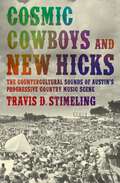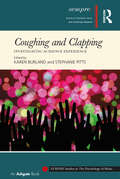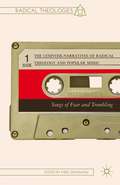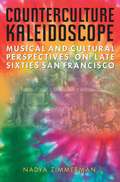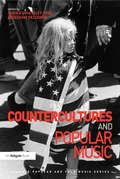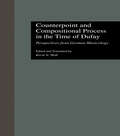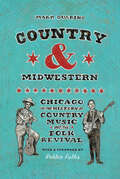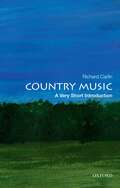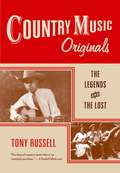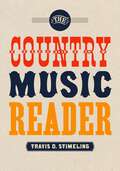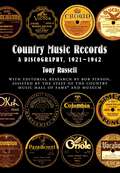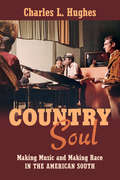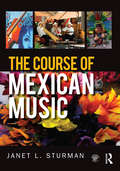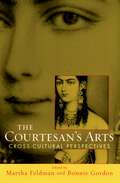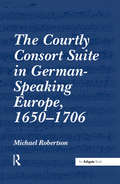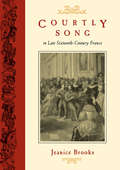- Table View
- List View
Cosmic Cowboys and New Hicks: The Countercultural Sounds of Austin's Progressive Country Music Scene
by Travis D. StimelingCountry music of late 1960s and early 1970s was a powerful symbol of staunch conservative resistance to the flowering hippie counterculture. But in 1972, the city of Austin, Texas became host to a growing community of musicians, entrepreneurs, journalists, and fans who saw country music as a part of their collective heritage and sought to reclaim it for their own progressive scene. These children of the Cold War, post-World War II suburban migration, and the Baby Boom escaped the socially conservative world their parents had created, to instead create for themselves an idyllic rural Texan utopia. Progressive country music--a hybrid of country music and rock--played out the contradictions at work among the residents of the growing Austin community: at once firmly grounded in the conservative Texan culture in which they had been raised and profoundly affected by the current hippie counterculture. In Cosmic Cowboys and New Hicks: The Countercultural Sounds of Austin's Progressive Country Music Scene, Travis Stimeling connects the local Austin culture and the progressive music that became its trademark. He presents a colorful range of evidence, from behavior and dress, to newspaper articles, to personal interviews of musicians as diverse as Willie Nelson, Jerry Jeff Walker, and Doug Sahm. Along the way, Stimeling uncovers parodies of the cosmic cowboy image that reinforce the longing for a more peaceful way of life, but that also recognize an awareness of the muddled, conflicted nature of this counterculture identity. Cosmic Cowboys and New Hicks brings new insight into the inner workings of Austin's progressive country music scene -- by bringing the music and musicians brilliantly to life. This book will appeal to students and scholars of popular music studies, musicology and ethnomusicology, sociology, cultural studies, folklore, American studies, and cultural geography; the lucid prose and interviews will also make the book attractive to fans of the genre and artists discussed within. Austin residents past and present, as well as anyone with an interest in the development of progressive music or today's 'alt.country' movement will find Cosmic Cowboys and New Hicks an informative, engaging resource.
Coughing and Clapping: Investigating Audience Experience (SEMPRE Studies in The Psychology of Music)
by Karen Burland Stephanie PittsCoughing and Clapping: Investigating Audience Experience explores the processes and experiences of attending live music events from the initial decision to attend through to audience responses and memories of a performance after it has happened. The book brings together international researchers who consider the experience of being an audience member from a range of theoretical and empirical perspectives. Whether enjoying a drink at a jazz gig, tweeting at a pop concert or suppressing a cough at a classical recital, audience experience is affected by motivation, performance quality, social atmosphere and group and personal identity. Drawing on the implications of these experiences and attitudes, the authors consider the question of what makes an audience, and argue convincingly for the practical and academic value of that question.
Coughing and Clapping: Investigating Audience Experience (SEMPRE Studies in The Psychology of Music)
by Karen Burland Stephanie PittsCoughing and Clapping: Investigating Audience Experience explores the processes and experiences of attending live music events from the initial decision to attend through to audience responses and memories of a performance after it has happened. The book brings together international researchers who consider the experience of being an audience member from a range of theoretical and empirical perspectives. Whether enjoying a drink at a jazz gig, tweeting at a pop concert or suppressing a cough at a classical recital, audience experience is affected by motivation, performance quality, social atmosphere and group and personal identity. Drawing on the implications of these experiences and attitudes, the authors consider the question of what makes an audience, and argue convincingly for the practical and academic value of that question.
The Counter-Narratives of Radical Theology and Popular Music: Songs of Fear and Trembling (Radical Theologies and Philosophies)
by Mike GrimshawIn this unique collection, theologians born and formed during the Cold War offer their insights and perspectives on theological relationships with such musical artists and groups as Joy Division, U2, Nick Cave, and John Coltrane. These essays demonstrate that one's personal music preferences can inform and influence professional interests.
Counterculture Kaleidoscope: Musical and Cultural Perspectives on Late Sixties San Francisco
by Nadya ZimmermanForty years after the fact, 1960s counterculture---personified by hippies, protest, and the Summer of Love---basks in a nostalgic glow in the popular imagination as a turning point in modern American history and the end of the age of innocence. Yet, while the era has come to be synonymous with rebellion and opposition, its truth is much more complex. In a bold reconsideration of the late sixties San Francisco counterculture movement, Counterculture Kaleidoscope takes a close look at the cultural and musical practices of that era. Addressing the conventional wisdom that the movement was grounded in rebellion and opposition, the book exposes two myths: first, that the counterculture was an organized social and political movement of progressives with a shared agenda who opposed the mainstream (dubbed "hippies"); and second, that the counterculture was an innocent entity hijacked by commercialism and transformed over time into a vehicle of so-called "hip consumerism." Seeking an alternative to the now common narrative, Nadya Zimmerman examines primary source material including music, artwork, popular literature, personal narratives, and firsthand historical accounts. She reveals that the San Francisco counterculture wasn't interested in commitments to causes and made no association with divisive issues---that it embraced everything in general and nothing in particular. "Astute and accessible, Counterculture Kaleidoscope provides thought-provoking insights into the historical, cultural and social context of the San Francisco counter-culture and its music scene, including discussions of Vietnam and student protest, the Haight-Ashbury Diggers, the Grateful Dead, Led Zeppelin, Altamont, and Charlie Manson. A must for students and scholars of socio-musical activity and for all of us to whom music matters." ---Sheila Whiteley, author of The Space Between the Notes: Rock and the Counter-Culture and Too Much Too Young: Popular Music, Age and Gender "The hippie counterculture has never garnered the scholarly attention accorded the new left and the black freedom struggle. Overviews of the period ritualistically mention it as part and parcel of that apparently incandescent era---the Sixties---but rarely capture its distinctiveness. Counterculture Kaleidoscope is a timely and provocative intervention in Sixties scholarship that significantly deepens our understanding of this important but understudied phenomenon." —Alice Echols, Associate Professor, University of Southern California, and author of Scars of Sweet Paradise: The Life and Times of Janis Joplin
Countercultures and Popular Music (Ashgate Popular and Folk Music Series)
by Sheila Whiteley Jedediah Sklower’Counterculture’ emerged as a term in the late 1960s and has been re-deployed in more recent decades in relation to other forms of cultural and socio-political phenomena. This volume provides an essential new academic scrutiny of the concept of ’counterculture’ and a critical examination of the period and its heritage. Recent developments in sociological theory complicate and problematise theories developed in the 1960s, with digital technology, for example, providing an impetus for new understandings of counterculture. Music played a significant part in the way that the counterculture authored space in relation to articulations of community by providing a shared sense of collective identity. Not least, the heady mixture of genres provided a socio-cultural-political backdrop for distinctive musical practices and innovations which, in relation to counterculture ideology, provided a rich experiential setting in which different groups defined their relationship both to the local and international dimensions of the movement, so providing a sense of locality, community and collective identity.
Countercultures and Popular Music (Ashgate Popular and Folk Music Series)
by Sheila Whiteley Jedediah Sklower’Counterculture’ emerged as a term in the late 1960s and has been re-deployed in more recent decades in relation to other forms of cultural and socio-political phenomena. This volume provides an essential new academic scrutiny of the concept of ’counterculture’ and a critical examination of the period and its heritage. Recent developments in sociological theory complicate and problematise theories developed in the 1960s, with digital technology, for example, providing an impetus for new understandings of counterculture. Music played a significant part in the way that the counterculture authored space in relation to articulations of community by providing a shared sense of collective identity. Not least, the heady mixture of genres provided a socio-cultural-political backdrop for distinctive musical practices and innovations which, in relation to counterculture ideology, provided a rich experiential setting in which different groups defined their relationship both to the local and international dimensions of the movement, so providing a sense of locality, community and collective identity.
Counterpoint and Compositional Process in the Time of Dufay: Perspectives from German Musicology
by Kevin N. MollFirst Published in 1998. Routledge is an imprint of Taylor & Francis, an informa company.
Counterpoint and Compositional Process in the Time of Dufay: Perspectives from German Musicology
by Kevin N. MollFirst Published in 1998. Routledge is an imprint of Taylor & Francis, an informa company.
Country and Midwestern: Chicago in the History of Country Music and the Folk Revival (Emersion: Emergent Village Resources For Communities Of Faith Ser.)
by Mark GuarinoThe untold story of Chicago’s pivotal role as a country and folk music capital. Chicago is revered as a musical breeding ground, having launched major figures like blues legend Muddy Waters, gospel soul icon Mavis Staples, hip-hop firebrand Kanye West, and the jazz-rock band that shares its name with the city. Far less known, however, is the vital role Chicago played in the rise of prewar country music, the folk revival of the 1950s and 1960s, and the contemporary offspring of those scenes. In Country and Midwestern, veteran journalist Mark Guarino tells the epic century-long story of Chicago’s influence on sounds typically associated with regions further south. Drawing on hundreds of interviews and deep archival research, Guarino tells a forgotten story of music, migration, and the ways that rural culture infiltrated urban communities through the radio, the automobile, and the railroad. The Midwest’s biggest city was the place where rural transplants could reinvent themselves and shape their music for the new commercial possibilities the city offered. Years before Nashville emerged as the commercial and spiritual center of country music, major record labels made Chicago their home and recorded legendary figures like Bill Monroe, The Carter Family, and Gene Autry. The National Barn Dance—broadcast from the city’s South Loop starting in 1924—flourished for two decades as the premier country radio show before the Grand Ole Opry. Guarino chronicles the makeshift niche scenes like “Hillbilly Heaven” in Uptown, where thousands of relocated Southerners created their own hardscrabble honky-tonk subculture, as well as the 1960s rise of the Old Town School of Folk Music, which eventually brought national attention to local luminaries like John Prine and Steve Goodman. The story continues through the end of the twentieth century and into the present day, where artists like Jon Langford, The Handsome Family, and Wilco meld contemporary experimentation with country traditions. Featuring a foreword from Grammy-nominated singer-songwriter Robbie Fulks and casting a cross-genre net that stretches from Bob Dylan to punk rock, Country and Midwestern rediscovers a history as sprawling as the Windy City—celebrating the creative spirit that modernized American folk idioms, the colorful characters who took them into new terrain, and the music itself, which is still kicking down doors even today.
Country Music: A Biographical Dictionary (Very Short Introductions)
by Richard CarlinCountry Music: A Very Short Introduction presents a compelling overview of the music and its impact on American culture. Country music has long been a marker of American identity; from our popular culture to our politics, it has provided a soundtrack to our national life. While traditionally associated with the working class, country's appeal is far broader than any other popular music style. While this music rose from the people, it is also a product of the popular music industry, and the way the music has been marketed to its audience is a key part of its story. Key artists, songs, and musical styles are highlighted that are either touchstones for a particular social event (such as Tammy Wynette's "Stand By Your Man," which produced both a positive and negative backlash as a marker of women's roles in society at the beginning of the liberation movement) or that encompass broader trends in the industry (for example, Jimmie Rodgers' "T for Texas" was an early example of the appropriation of black musical forms by white artists to market them to a mainstream audience). While pursuing a basically chronological outline, the book is structured around certain recurring themes (such as rural vs. urban; tradition vs. innovation; male vs. female; white vs. black) that have been documented through the work of country artists from the minstrel era to today. Truly the voice of the people, country music expresses both deep patriotism as well as a healthy skepticism towards the powers that dominate American society. Country Music: A Very Short Introduction illuminates this rich tradition and assesses its legacy in American popular music culture.
Country Music Originals: The Legends and the Lost
by Tony RussellGraced by more than 200 illustrations, many of them seldom seen and some never before published, this sparkling volume offers vivid portraits of the men and women who created country music, the artists whose lives and songs formed the rich tradition from which so many others have drawn inspiration. Included here are not only such major figures as Jimmie Rodgers, The Carter Family, Fiddlin' John Carson, Charlie Poole, and Gene Autry, who put country music on America's cultural map, but many fascinating lesser-known figures as well, such as Carson Robison, Otto Gray, Chris Bouchillon, Emry Arthur and dozens more, many of whose stories are told here for the first time. To map some of the winding, untraveled roads that connect today's music to its ancestors, Tony Russell draws upon new research and rare source material, such as contemporary newspaper reports and magazine articles, internet genealogy sites, and his own interviews with the musicians or their families. The result is a lively mix of colorful tales and anecdotes, priceless contemporary accounts of performances, illuminating social and historical context, and well-grounded critical judgment. The illustrations include artist photographs, record labels, song sheets, newspaper clippings, cartoons, and magazine covers, recreating the look and feel of the entire culture of country music. Each essay includes as well a playlist of recommended and currently available recordings for each artist. Finally, the paperback edition now features an extensive index.
Country Music Originals: The Legends and the Lost
by Tony RussellGraced by more than 200 illustrations, many of them seldom seen and some never before published, this sparkling volume offers vivid portraits of the men and women who created country music, the artists whose lives and songs formed the rich tradition from which so many others have drawn inspiration. Included here are not only such major figures as Jimmie Rodgers, The Carter Family, Fiddlin' John Carson, Charlie Poole, and Gene Autry, who put country music on America's cultural map, but many fascinating lesser-known figures as well, such as Carson Robison, Otto Gray, Chris Bouchillon, Emry Arthur and dozens more, many of whose stories are told here for the first time. To map some of the winding, untraveled roads that connect today's music to its ancestors, Tony Russell draws upon new research and rare source material, such as contemporary newspaper reports and magazine articles, internet genealogy sites, and his own interviews with the musicians or their families. The result is a lively mix of colorful tales and anecdotes, priceless contemporary accounts of performances, illuminating social and historical context, and well-grounded critical judgment. The illustrations include artist photographs, record labels, song sheets, newspaper clippings, cartoons, and magazine covers, recreating the look and feel of the entire culture of country music. Each essay includes as well a playlist of recommended and currently available recordings for each artist. Finally, the paperback edition now features an extensive index.
The Country Music Reader
by Travis D. StimelingIn The Country Music Reader Travis D. Stimeling provides an anthology of primary source readings from newspapers, magazines, and fan ephemera encompassing the history of country music from circa 1900 to the present. Presenting conversations that have shaped historical understandings of country music, it brings the voices of country artists and songwriters, music industry insiders, critics, and fans together in a vibrant conversation about a widely loved yet seldom studied genre of American popular music. Situating each source chronologically within its specific musical or cultural context, Stimeling traces the history of country music from the fiddle contests and ballad collections of the late nineteenth and early twentieth centuries through the most recent developments in contemporary country music. Drawing from a vast array of sources including popular magazines, fan newsletters, trade publications, and artist biographies, The Country Music Reader offers firsthand insight into the changing role of country music within both the music industry and American musical culture, and presents a rich resource for university students, popular music scholars, and country music fans alike.
COUNTRY MUSIC READER C
by Travis D. StimelingIn The Country Music Reader Travis D. Stimeling provides an anthology of primary source readings from newspapers, magazines, and fan ephemera encompassing the history of country music from circa 1900 to the present. Presenting conversations that have shaped historical understandings of country music, it brings the voices of country artists and songwriters, music industry insiders, critics, and fans together in a vibrant conversation about a widely loved yet seldom studied genre of American popular music. Situating each source chronologically within its specific musical or cultural context, Stimeling traces the history of country music from the fiddle contests and ballad collections of the late nineteenth and early twentieth centuries through the most recent developments in contemporary country music. Drawing from a vast array of sources including popular magazines, fan newsletters, trade publications, and artist biographies, The Country Music Reader offers firsthand insight into the changing role of country music within both the music industry and American musical culture, and presents a rich resource for university students, popular music scholars, and country music fans alike.
Country Music Records: A Discography, 1921-1942
by Tony Russell Bob PinsonMore than twenty years in the making, Country Music Records documents all country music recording sessions from 1921 through 1942. With primary research based on files and session logs from record companies, interviews with surviving musicians, as well as the 200,000 recordings archived at the Country Music Hall of Fame and Museum's Frist Library and Archives, this notable work is the first compendium to accurately report the key details behind all the recording sessions of country music during the pre-World War II era. This discography documents--in alphabetical order by artist--every commercial country music recording, including unreleased sides, and indicates, as completely as possible, the musicians playing at every session, as well as instrumentation. This massive undertaking encompasses 2,500 artists, 5,000 session musicians, and 10,000 songs. Summary histories of each key record company are also provided, along with a bibliography. The discography includes indexes to all song titles and musicians listed.
Country Music Records: A Discography, 1921-1942
by Tony Russell Bob PinsonMore than twenty years in the making, Country Music Records documents all country music recording sessions from 1921 through 1942. With primary research based on files and session logs from record companies, interviews with surviving musicians, as well as the 200,000 recordings archived at the Country Music Hall of Fame and Museum's Frist Library and Archives, this notable work is the first compendium to accurately report the key details behind all the recording sessions of country music during the pre-World War II era. This discography documents--in alphabetical order by artist--every commercial country music recording, including unreleased sides, and indicates, as completely as possible, the musicians playing at every session, as well as instrumentation. This massive undertaking encompasses 2,500 artists, 5,000 session musicians, and 10,000 songs. Summary histories of each key record company are also provided, along with a bibliography. The discography includes indexes to all song titles and musicians listed.
Country Music: A Very Short Introduction (Very Short Introductions)
by Richard CarlinCountry Music: A Very Short Introduction presents a compelling overview of the music and its impact on American culture. Country music has long been a marker of American identity; from our popular culture to our politics, it has provided a soundtrack to our national life. While traditionally associated with the working class, country's appeal is far broader than any other popular music style. While this music rose from the people, it is also a product of the popular music industry, and the way the music has been marketed to its audience is a key part of its story. Key artists, songs, and musical styles are highlighted that are either touchstones for a particular social event (such as Tammy Wynette's "Stand By Your Man," which produced both a positive and negative backlash as a marker of women's roles in society at the beginning of the liberation movement) or that encompass broader trends in the industry (for example, Jimmie Rodgers' "T for Texas" was an early example of the appropriation of black musical forms by white artists to market them to a mainstream audience). While pursuing a basically chronological outline, the book is structured around certain recurring themes (such as rural vs. urban; tradition vs. innovation; male vs. female; white vs. black) that have been documented through the work of country artists from the minstrel era to today. Truly the voice of the people, country music expresses both deep patriotism as well as a healthy skepticism towards the powers that dominate American society. Country Music: A Very Short Introduction illuminates this rich tradition and assesses its legacy in American popular music culture.
Country Soul: Making Music and Making Race in the American South
by Charles L. HughesIn the sound of the 1960s and 1970s, nothing symbolized the rift between black and white America better than the seemingly divided genres of country and soul. Yet the music emerged from the same songwriters, musicians, and producers in the recording studios of Memphis and Nashville, Tennessee, and Muscle Shoals, Alabama--what Charles L. Hughes calls the "country-soul triangle." In legendary studios like Stax and FAME, integrated groups of musicians like Booker T. and the MGs and the Muscle Shoals Rhythm Section produced music that both challenged and reconfirmed racial divisions in the United States. Working with artists from Aretha Franklin to Willie Nelson, these musicians became crucial contributors to the era's popular music and internationally recognized symbols of American racial politics in the turbulent years of civil rights protests, Black Power, and white backlash. Hughes offers a provocative reinterpretation of this key moment in American popular music and challenges the conventional wisdom about the racial politics of southern studios and the music that emerged from them. Drawing on interviews and rarely used archives, Hughes brings to life the daily world of session musicians, producers, and songwriters at the heart of the country and soul scenes. In doing so, he shows how the country-soul triangle gave birth to new ways of thinking about music, race, labor, and the South in this pivotal period.
The Course of Mexican Music
by Janet SturmanThe Course of Mexican Music provides students with a cohesive introductory understanding of the scope and influence of Mexican music. The textbook highlights individual musical examples as a means of exploring the processes of selection that led to specific musical styles in different times and places, with a supporting companion website with audio and video tracks helping to reinforce readers' understanding of key concepts. The aim is for students to learn an exemplary body of music as a window for understanding Mexican music, history and culture in a manner that reveals its importance well beyond the borders of that nation.
The Course of Mexican Music
by Janet SturmanThe Course of Mexican Music provides students with a cohesive introductory understanding of the scope and influence of Mexican music. The textbook highlights individual musical examples as a means of exploring the processes of selection that led to specific musical styles in different times and places, with a supporting companion website with audio and video tracks helping to reinforce readers' understanding of key concepts. The aim is for students to learn an exemplary body of music as a window for understanding Mexican music, history and culture in a manner that reveals its importance well beyond the borders of that nation.
The Courtesan's Arts: Cross-Cultural Perspectives
by Martha Feldman Bonnie GordonCourtesans, hetaeras, tawaif-s, ji-s--these women have exchanged artistic graces, elevated conversation, and sexual favors with male patrons throughout history and around the world. Of a different world than common prostitutes, courtesans deal in artistic and intellectual pleasures in ways that are wholly interdependent with their commerce in sex. In pre-colonial India, courtesans cultivated a wide variety of artistic skills, including magic, music, and chemistry. In Ming dynasty China, courtesans communicated with their patrons through poetry and music. Yet because these cultural practices have existed primarily outside our present-day canons of art and have often occurred through oral transmission, courtesans' arts have vanished almost without trace. The Courtesan's Arts delves into this hidden legacy, unveiling the artistic practices and cultural production of courtesan cultures with a sideways glance at the partly-related geisha. Balancing theoretical and empirical research, this interdisciplinary collection is the first of its kind to explore courtesan cultures through diverse case studies--the Edo period and modern Japan, 20th-century Korea, Ming dynasty China, ancient Greece, early modern Italy, and India, past and present. Each essay puts forward new perspectives on how the arts have figured in the courtesan's survival or demise. Though performative and often flamboyant, courtesans have been enigmatic and elusive to their beholders--including scholars. They have shaped cultures through art, yet their arts, often intangible, have all but faded from view. Often courtesans have hovered in the crevices of space, time, and practice--between gifts and money, courts and cities, feminine allure and masculine power, as substitutes for wives but keepers of culture. Reproductively irrelevant, they have tended to be ambiguous figures, thriving on social distinction while operating outside official familial relations. They have symbolized desirability and sophistication yet often been reviled as decadent. The Courtesan's Arts shows that while courtesans cultures have appeared regularly in various times and places, they are universal neither as a phenomenon nor as a type. To the contrary, when they do crop up, wide variations exist. What binds together courtesans and their arts in the present-day post-industrialized world of global services and commodities is their fragility. Once vital to cultures of leisure and pleasure, courtesans are now largely forgotten, transformed into national icons or historical curiosities, or reduced to prostitution.
The Courtly Consort Suite in German-Speaking Europe, 1650-1706
by Michael RobertsonDance music at the courts of seventeenth-century Germany is a genre that is still largely unknown. Dr Michael Robertson sets out to redress the balance and study the ensemble dance suites that were played at the German courts between the end of the Thirty Years War and the early years of the eighteenth century. At many German courts during this time, it was fashionable to emulate everything that was French. As part of this process, German musicians visited Paris throughout the second half of the seventeenth century, and brought French courtly music back with them on their return. For the last two decades of the century, this meant the works of Jean-Baptiste Lully, and his music and its influence spread rapidly through the courts of Europe. Extracts from Lully's dramatic stage works were circulated in both published editions and manuscript. These extracts are considered in some detail, especially in terms of their relationship to the suite. The nobility also played their part in this process: French musicians and German players with specialist knowledge were often hired to coach their German colleagues in the art of playing in the French manner, the franz‘sischer Art. The book examines the dissemination of dance music, instrumentation and performance practice, and the differences between the French and Italian styles. It also studies the courtly suites before the advent of Lullism and the differences between the suites of court composers and town musicians. With the possible exception of Georg Muffat's two Florilegium collections of suites, much of the dance music of the German Lullists is largely unknown; court composers such as Cousser, Erlebach, Johann Fischer and Johann Caspar Ferdinand Fischer all wrote fine collections of ensemble suites, and these are examined in detail. Examples from these suites, some published for the first time, are given throughout the book in order to demonstrate the music's quality and show that its neglect is completely unjustifi
The Courtly Consort Suite in German-Speaking Europe, 1650-1706
by Michael RobertsonDance music at the courts of seventeenth-century Germany is a genre that is still largely unknown. Dr Michael Robertson sets out to redress the balance and study the ensemble dance suites that were played at the German courts between the end of the Thirty Years War and the early years of the eighteenth century. At many German courts during this time, it was fashionable to emulate everything that was French. As part of this process, German musicians visited Paris throughout the second half of the seventeenth century, and brought French courtly music back with them on their return. For the last two decades of the century, this meant the works of Jean-Baptiste Lully, and his music and its influence spread rapidly through the courts of Europe. Extracts from Lully's dramatic stage works were circulated in both published editions and manuscript. These extracts are considered in some detail, especially in terms of their relationship to the suite. The nobility also played their part in this process: French musicians and German players with specialist knowledge were often hired to coach their German colleagues in the art of playing in the French manner, the franz‘sischer Art. The book examines the dissemination of dance music, instrumentation and performance practice, and the differences between the French and Italian styles. It also studies the courtly suites before the advent of Lullism and the differences between the suites of court composers and town musicians. With the possible exception of Georg Muffat's two Florilegium collections of suites, much of the dance music of the German Lullists is largely unknown; court composers such as Cousser, Erlebach, Johann Fischer and Johann Caspar Ferdinand Fischer all wrote fine collections of ensemble suites, and these are examined in detail. Examples from these suites, some published for the first time, are given throughout the book in order to demonstrate the music's quality and show that its neglect is completely unjustifi
Courtly Song in Late Sixteenth-Century France
by Jeanice BrooksIn the late sixteenth century, the French royal court was mobile. To distinguish itself from the rest of society, it depended more on its cultural practices and attitudes than on the royal and aristocratic palaces it inhabited. Using courtly song-or the air de cour-as a window, Jeanice Brooks offers an unprecedented look into the culture of this itinerant institution. Brooks concentrates on a period in which the court's importance in projecting the symbolic centrality of monarchy was growing rapidly and considers the role of the air in defining patronage hierarchies at court and in enhancing courtly visions of masculine and feminine virtue. Her study illuminates the court's relationship to the world beyond its own confines, represented first by Italy, then by the countryside. In addition to the 40 editions of airs de cour printed between 1559 and 1589, Brooks draws on memoirs, literary works, and iconographic evidence to present a rounded vision of French Renaissance culture. The first book-length examination of the history of air de cour, this work also sheds important new light on a formative moment in French history.
